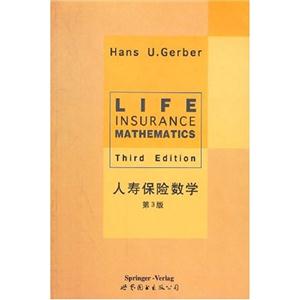人寿保险数学-第3版
本书特色
[
Two major developments have influenced the environment of actuarial math-ematics. One is the arrival of powerful and affordable computers; the onceimportant problem of numerical calculation has become almost trivial in many instances. The other is the fact that today’s generation is quite familiar with probability theory in an intuitive sense; the basic concepts of probability theory are taught at man), high schools. These two factors should be taken into account in the teaching and learning of actuarial mathematics. A first consequence is, for example, that a recursive algorithm (for a solution) is as useful as a solution expressed in terms of commutation functions. In many cases the calculations are easy; thus the question “why” a calculation is done is much more important than the question “how” it is done. The second consequence is that the somewhat embarrassing deterministic model can be abandoned; nowadays nothing speaks against the use of the stochastic model, which better reflects the mechanisms of insurance. Thus the discussion does not have to be limited to expected values; it can be extended to the deviations from the expected values, thereby quantifying the risk in the proper sense.
本书为英文版。
]
目录
1 The Mathematics of Compound Interest1.1 Mathematical Bases of Life Contingencies1.2 Effective Interest Rates1.3 Nominal Interest Rates1.4 Continuous Payments1.5 Interest in Advance1.6 Perpetuities1.7 Annuities1.8 Repayment ofa Debt1.9 Internal Rate of Return2 The Future Lifetime of a Life Aged x2.1 The Model2.2 The Force of Mortality2.3 Analytical Distributions of T2.4 The Curtate Future Lifetime of (x)2.5 Life Tables2.6 Probabilities of Death for Fractions of a Year3 Life Insurance3.1 Introduction3.2 Elementary Insurance Types3.2.1 Whole Life and Term Insurance3.2.2 Pure Endowments3.2.3 Endowments3.3 Insurances Payable at the Moment of Death3.4 General Types of Life Insurance3.5 Standard Types of Variable Life Insurance3.6 Recursive Formulae4 Life Annuities4.1 Introduction4.2 Elementary Life Annuities4.3 Payments made more Frequently than Once a Year4.4 Variable Life Annuities4.5 Standard Types of Life Annuituy4.6 Recursion Formulae4.7 Inequalities4.8 Payments Starting at Non-iutegral Ages5 Net Premiums5.1 Introduction5.2 An Example5.3 Elementary Forms of Insurance5.3.1 Whole Life and Term Insurance5.3.2 Pure Endowments5.3.3 Endowments5.3.4 Deferred Life Annuities5.4 Premiums Paid m Times a Year5.5 A General Type of Life Insurance5.6 Policies with Premium Refund5.7 Stochastic Interest6 Net Premium Reserves6.1 Introduction6.2 Two Examples6.3 Recursive Considerations6.4 The Survival Risk6.5 The Net Premium Reserve of a Whole Life Insurance6.6 Net Premium Reserves at Fractional Durations6.7 Allocation of the Overall Loss to Policy Years6.8 Conversion of an Insurance6.9 Technical Gain6.10 Procedure for Pure Endowments6.11 The Continuous Model7 Multiple Decrementsl8 Multiple Life Insurance9 The Total Claim Amount in a Portfolio10 Expense Loadings11 Estimating Probabilities of DeathAppendix A. Commutation FunctionsAppendix B. Simple InterestAppendix C. ExercisesAppendix D. SolutionsAppendix E. TablesReferencesIndex
封面

书名:人寿保险数学-第3版
作者:暂无
页数:217 页
定价:¥39.0
出版社:世界图书出版公司
出版日期:1999-10-01
ISBN:9787506214704
PDF电子书大小:64MB 高清扫描完整版
